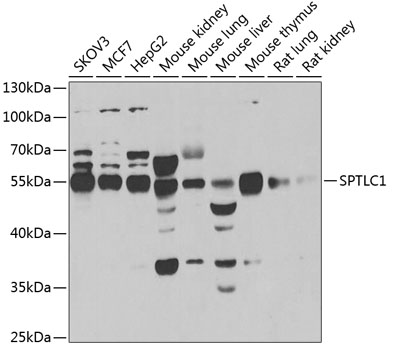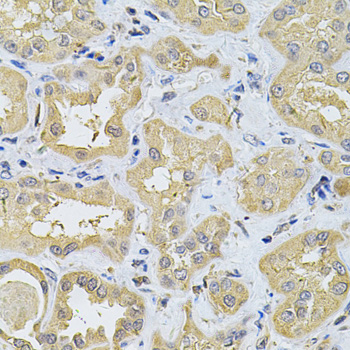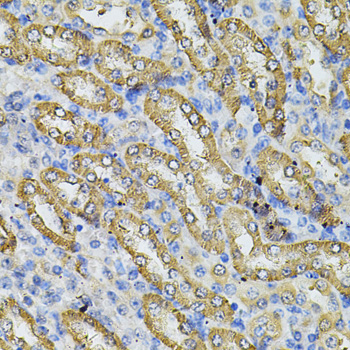Metabolism Antibodies 2
Anti-SPTLC1 Antibody (CAB6750)
- SKU:
- CAB6750
- Product Type:
- Antibody
- Reactivity:
- Human
- Reactivity:
- Mouse
- Reactivity:
- Rat
- Host Species:
- Rabbit
- Isotype:
- IgG
- Antibody Type:
- Polyclonal Antibody
- Research Area:
- Metabolism
Description
| Antibody Name: | Anti-SPTLC1 Antibody |
| Antibody SKU: | CAB6750 |
| Antibody Size: | 20uL, 50uL, 100uL |
| Application: | WB IHC |
| Reactivity: | Human, Mouse, Rat |
| Host Species: | Rabbit |
| Immunogen: | Recombinant fusion protein containing a sequence corresponding to amino acids 37-310 of human SPTLC1 (NP_006406.1). |
| Application: | WB IHC |
| Recommended Dilution: | WB 1:500 - 1:2000 IHC 1:50 - 1:200 |
| Reactivity: | Human, Mouse, Rat |
| Positive Samples: | SKOV3, MCF7, HepG2, Mouse kidney, Mouse lung, Mouse liver, Mouse thymus, Rat lung, Rat kidney |
| Immunogen: | Recombinant fusion protein containing a sequence corresponding to amino acids 37-310 of human SPTLC1 (NP_006406.1). |
| Purification Method: | Affinity purification |
| Storage Buffer: | Store at -20'C. Avoid freeze / thaw cycles. Buffer: PBS with 0.02% sodium azide, 50% glycerol, pH7.3. |
| Isotype: | IgG |
| Sequence: | RLLF SKTY KLQE RSDL TVKE KEEL IEEW QPEP LVPP VPKD HPAL NYNI VSGP PSHK TVVN GKEC INFA SFNF LGLL DNPR VKAA ALAS LKKY GVGT CGPR GFYG TFDV HLDL EDRL AKFM KTEE AIIY SYGF ATIA SAIP AYSK RGDI VFVD RAAC FAIQ KGLQ ASRS DIKL FKHN DMAD LERL LKEQ EIED QKNP RKAR VTRR FIVV EGLY MNTG TICP LPEL VKLK YKYK ARIF LEES LSFG VLGE HGRG VTEH YGIN IDDI DLIS ANME NA |
| Gene ID: | 10558 |
| Uniprot: | O15269 |
| Cellular Location: | Endoplasmic reticulum membrane, Single-pass membrane protein |
| Calculated MW: | 16kDa/52kDa |
| Observed MW: | 53kDa |
| Synonyms: | SPTLC1, HSAN1, HSN1, LBC1, LCB1, SPT1, SPTI |
| Background: | This gene encodes a member of the class-II pyridoxal-phosphate-dependent aminotransferase family. The encoded protein is the long chain base subunit 1 of serine palmitoyltransferase. Serine palmitoyltransferase converts L-serine and palmitoyl-CoA to 3-oxosphinganine with pyridoxal 5'-phosphate and is the key enzyme in sphingolipid biosynthesis. Mutations in this gene were identified in patients with hereditary sensory neuropathy type 1. Alternatively spliced variants encoding different isoforms have been identified. Pseudogenes of this gene have been defined on chromosomes 1, 6, 10, and 13. |
| UniProt Protein Function: | SPTLC1: Serine palmitoyltransferase (SPT). The heterodimer formed with SPTLC2 or SPTLC3 constitutes the catalytic core. The composition of the serine palmitoyltransferase (SPT) complex determines the substrate preference. The SPTLC1-SPTLC2-SPTSSA complex shows a strong preference for C16-CoA substrate, while the SPTLC1-SPTLC3-SPTSSA isozyme uses both C14-CoA and C16-CoA as substrates, with a slight preference for C14-CoA. The SPTLC1- SPTLC2-SPTSSB complex shows a strong preference for C18-CoA substrate, while the SPTLC1-SPTLC3-SPTSSB isozyme displays an ability to use a broader range of acyl-CoAs, without apparent preference. Defects in SPTLC1 are the cause of hereditary sensory and autonomic neuropathy type 1A (HSAN1A). The hereditary sensory and autonomic neuropathies are a genetically and clinically heterogeneous group of disorders characterized by degeneration of dorsal root and autonomic ganglion cells, and by sensory and/or autonomic abnormalities. HSAN1A is an autosomal dominant axonal neuropathy with onset in the second or third decades. Initial symptoms are loss of pain, touch, heat, and cold sensation over the feet, followed by distal muscle wasting and weakness. Loss of pain sensation leads to chronic skin ulcers and distal amputations. Belongs to the class-II pyridoxal-phosphate-dependent aminotransferase family. 2 isoforms of the human protein are produced by alternative splicing. |
| UniProt Protein Details: | Protein type:Lipid Metabolism - sphingolipid; EC 2.3.1.50; Membrane protein, integral; Transferase Chromosomal Location of Human Ortholog: 9q22.2 Cellular Component: endoplasmic reticulum membrane Molecular Function:protein binding; serine C-palmitoyltransferase activity Biological Process: ceramide biosynthetic process; sphingolipid biosynthetic process; sphingolipid metabolic process Disease: Neuropathy, Hereditary Sensory And Autonomic, Type Ia |
| NCBI Summary: | This gene encodes a member of the class-II pyridoxal-phosphate-dependent aminotransferase family. The encoded protein is the long chain base subunit 1 of serine palmitoyltransferase. Serine palmitoyltransferase converts L-serine and palmitoyl-CoA to 3-oxosphinganine with pyridoxal 5'-phosphate and is the key enzyme in sphingolipid biosynthesis. Mutations in this gene were identified in patients with hereditary sensory neuropathy type 1. Alternatively spliced variants encoding different isoforms have been identified. Pseudogenes of this gene have been defined on chromosomes 1, 6, 10, and 13. [provided by RefSeq, Jul 2013] |
| UniProt Code: | O15269 |
| NCBI GenInfo Identifier: | 6685579 |
| NCBI Gene ID: | 10558 |
| NCBI Accession: | O15269.1 |
| UniProt Secondary Accession: | O15269,Q5VWB4, Q96IX6, A8K681, |
| UniProt Related Accession: | O15269 |
| Molecular Weight: | 16,073 Da |
| NCBI Full Name: | Serine palmitoyltransferase 1 |
| NCBI Synonym Full Names: | serine palmitoyltransferase long chain base subunit 1 |
| NCBI Official Symbol: | SPTLC1 |
| NCBI Official Synonym Symbols: | HSN1; LBC1; LCB1; SPT1; SPTI; HSAN1 |
| NCBI Protein Information: | serine palmitoyltransferase 1 |
| UniProt Protein Name: | Serine palmitoyltransferase 1 |
| UniProt Synonym Protein Names: | Long chain base biosynthesis protein 1; LCB 1; Serine-palmitoyl-CoA transferase 1; SPT 1; SPT1 |
| Protein Family: | Serine palmitoyltransferase |
| UniProt Gene Name: | SPTLC1 |
| UniProt Entry Name: | SPTC1_HUMAN |
View AllClose









